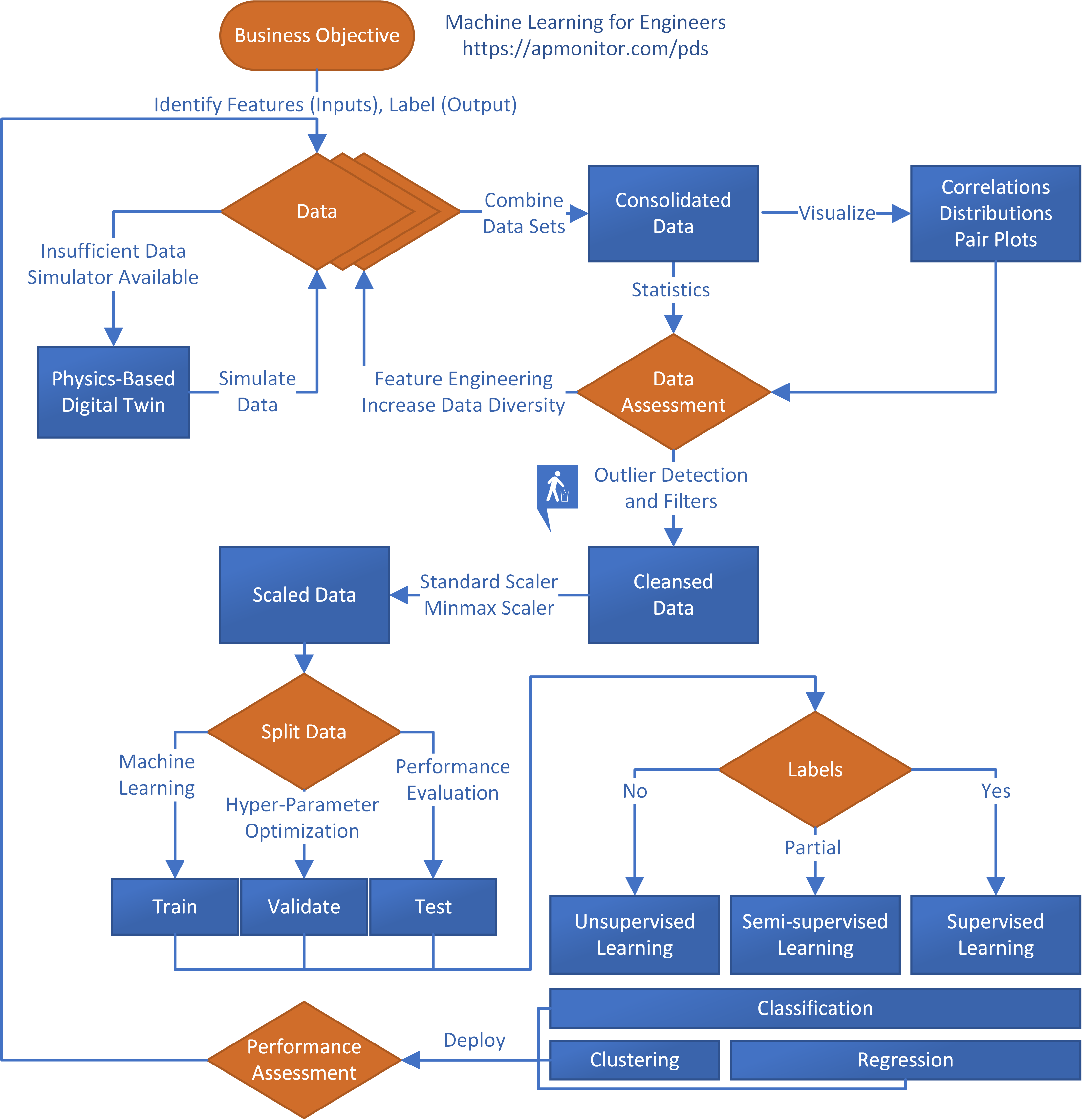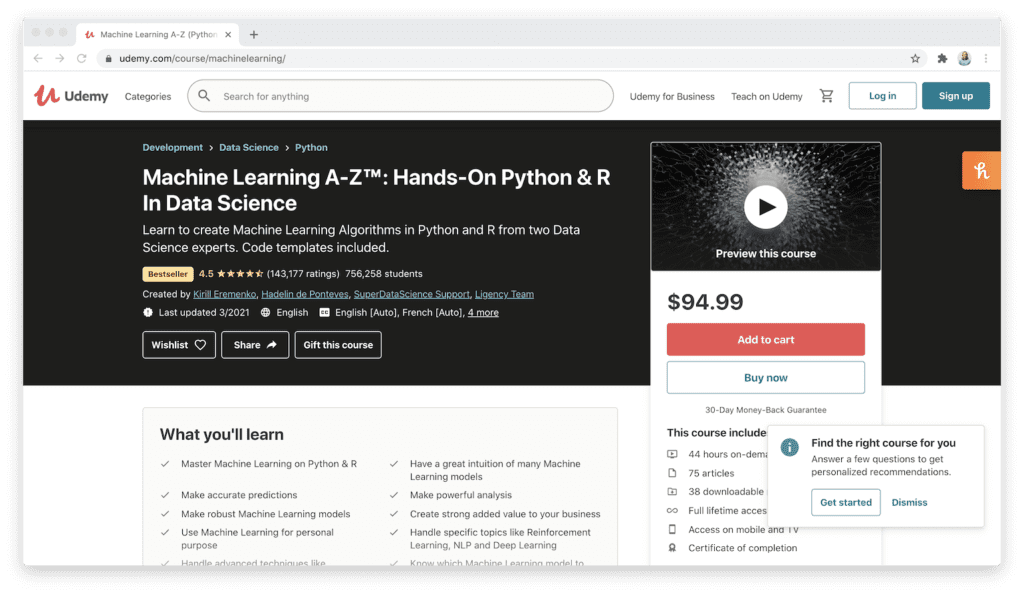All Categories
Featured
Table of Contents
- – Indicators on Training For Ai Engineers You Sh...
- – 8 Simple Techniques For Machine Learning & Ai ...
- – A Biased View of Software Developer (Ai/ml) C...
- – Not known Details About Machine Learning Cour...
- – How Machine Learning In Production / Ai Engi...
- – Some Known Questions About How I’d Learn Mac...
You most likely recognize Santiago from his Twitter. On Twitter, every day, he shares a lot of useful points concerning machine learning. Alexey: Before we go right into our main subject of moving from software application design to device knowing, maybe we can begin with your background.
I went to university, obtained a computer science level, and I started constructing software. Back after that, I had no concept concerning machine knowing.
I know you've been using the term "transitioning from software program engineering to artificial intelligence". I such as the term "including to my capability the artificial intelligence skills" extra due to the fact that I think if you're a software application engineer, you are currently giving a great deal of worth. By integrating artificial intelligence currently, you're augmenting the impact that you can carry the sector.
To make sure that's what I would certainly do. Alexey: This comes back to one of your tweets or maybe it was from your training course when you compare two strategies to discovering. One method is the issue based approach, which you simply discussed. You find an issue. In this case, it was some trouble from Kaggle about this Titanic dataset, and you just learn how to fix this problem making use of a specific tool, like decision trees from SciKit Learn.
Indicators on Training For Ai Engineers You Should Know
You first discover math, or straight algebra, calculus. Then when you understand the math, you most likely to artificial intelligence theory and you discover the theory. After that four years later, you finally concern applications, "Okay, exactly how do I utilize all these 4 years of math to solve this Titanic trouble?" ? In the previous, you kind of save yourself some time, I think.
If I have an electric outlet here that I require replacing, I don't intend to most likely to university, invest 4 years comprehending the math behind electrical power and the physics and all of that, simply to transform an electrical outlet. I prefer to start with the outlet and locate a YouTube video clip that helps me undergo the problem.
Santiago: I actually like the concept of starting with a trouble, trying to toss out what I recognize up to that problem and understand why it doesn't function. Get hold of the devices that I require to fix that problem and begin digging deeper and much deeper and much deeper from that point on.
Alexey: Possibly we can speak a little bit about learning sources. You discussed in Kaggle there is an introduction tutorial, where you can obtain and discover exactly how to make choice trees.
The only requirement for that training course is that you understand a little bit of Python. If you go to my profile, the tweet that's going to be on the top, the one that states "pinned tweet".
8 Simple Techniques For Machine Learning & Ai Courses - Google Cloud Training

Also if you're not a designer, you can start with Python and work your means to even more machine discovering. This roadmap is concentrated on Coursera, which is a platform that I actually, truly like. You can investigate every one of the courses totally free or you can pay for the Coursera subscription to get certificates if you wish to.
To ensure that's what I would do. Alexey: This returns to among your tweets or maybe it was from your training course when you compare 2 approaches to understanding. One strategy is the issue based method, which you just spoke about. You discover an issue. In this instance, it was some issue from Kaggle about this Titanic dataset, and you simply find out just how to fix this issue using a particular device, like decision trees from SciKit Learn.

You first find out math, or linear algebra, calculus. Then when you understand the math, you most likely to device learning concept and you discover the concept. Four years later on, you ultimately come to applications, "Okay, just how do I utilize all these 4 years of mathematics to address this Titanic issue?" Right? So in the previous, you kind of save yourself some time, I think.
If I have an electrical outlet right here that I require changing, I don't intend to most likely to college, invest four years understanding the mathematics behind power and the physics and all of that, just to change an outlet. I would certainly rather begin with the electrical outlet and locate a YouTube video that assists me experience the problem.
Bad example. Yet you obtain the concept, right? (27:22) Santiago: I really like the concept of beginning with a problem, trying to throw away what I recognize as much as that problem and recognize why it doesn't function. Get the devices that I need to solve that trouble and begin digging deeper and much deeper and much deeper from that point on.
To make sure that's what I normally recommend. Alexey: Maybe we can speak a little bit about discovering sources. You stated in Kaggle there is an intro tutorial, where you can get and learn exactly how to make decision trees. At the start, before we began this interview, you pointed out a number of publications too.
A Biased View of Software Developer (Ai/ml) Courses - Career Path
The only requirement for that course is that you know a little bit of Python. If you go to my account, the tweet that's going to be on the top, the one that says "pinned tweet".
Even if you're not a designer, you can begin with Python and function your method to more maker learning. This roadmap is concentrated on Coursera, which is a system that I really, actually like. You can investigate all of the courses free of cost or you can spend for the Coursera subscription to get certifications if you desire to.
Not known Details About Machine Learning Course - Learn Ml Course Online
Alexey: This comes back to one of your tweets or perhaps it was from your course when you compare two strategies to knowing. In this case, it was some issue from Kaggle regarding this Titanic dataset, and you just find out just how to fix this issue utilizing a particular device, like choice trees from SciKit Learn.

You initially find out mathematics, or linear algebra, calculus. When you know the mathematics, you go to machine learning concept and you learn the theory.
If I have an electrical outlet right here that I require replacing, I don't wish to most likely to college, invest 4 years comprehending the math behind electricity and the physics and all of that, just to change an outlet. I prefer to start with the electrical outlet and find a YouTube video that helps me experience the issue.
Santiago: I really like the concept of beginning with a problem, trying to throw out what I recognize up to that problem and recognize why it does not work. Order the devices that I need to resolve that trouble and start digging deeper and deeper and much deeper from that point on.
That's what I normally recommend. Alexey: Perhaps we can speak a little bit about learning resources. You discussed in Kaggle there is an introduction tutorial, where you can obtain and find out how to make choice trees. At the beginning, prior to we started this interview, you discussed a number of publications as well.
How Machine Learning In Production / Ai Engineering can Save You Time, Stress, and Money.
The only demand for that course is that you recognize a bit of Python. If you're a programmer, that's an excellent beginning point. (38:48) Santiago: If you're not a programmer, then I do have a pin on my Twitter account. If you most likely to my profile, the tweet that's going to be on the top, the one that claims "pinned tweet".
Also if you're not a programmer, you can start with Python and work your means to even more artificial intelligence. This roadmap is concentrated on Coursera, which is a system that I truly, really like. You can examine every one of the training courses for complimentary or you can pay for the Coursera subscription to get certificates if you intend to.
Alexey: This comes back to one of your tweets or perhaps it was from your course when you contrast two approaches to knowing. In this case, it was some problem from Kaggle regarding this Titanic dataset, and you just discover how to solve this issue using a details tool, like choice trees from SciKit Learn.
You initially find out math, or linear algebra, calculus. When you understand the mathematics, you go to device discovering concept and you find out the concept.
Some Known Questions About How I’d Learn Machine Learning In 2024 (If I Were Starting ....
If I have an electric outlet below that I require changing, I don't wish to go to college, spend 4 years understanding the math behind power and the physics and all of that, simply to alter an outlet. I would rather start with the electrical outlet and discover a YouTube video clip that helps me experience the trouble.
Santiago: I really like the idea of starting with a problem, attempting to throw out what I know up to that trouble and recognize why it doesn't work. Order the tools that I need to solve that problem and begin excavating deeper and much deeper and much deeper from that factor on.

Alexey: Possibly we can speak a bit about discovering resources. You discussed in Kaggle there is an intro tutorial, where you can obtain and learn just how to make decision trees.
The only requirement for that course is that you know a little bit of Python. If you go to my account, the tweet that's going to be on the top, the one that states "pinned tweet".
Also if you're not a programmer, you can start with Python and work your way to even more artificial intelligence. This roadmap is focused on Coursera, which is a system that I truly, really like. You can examine every one of the training courses for complimentary or you can pay for the Coursera subscription to get certifications if you wish to.
Table of Contents
- – Indicators on Training For Ai Engineers You Sh...
- – 8 Simple Techniques For Machine Learning & Ai ...
- – A Biased View of Software Developer (Ai/ml) C...
- – Not known Details About Machine Learning Cour...
- – How Machine Learning In Production / Ai Engi...
- – Some Known Questions About How I’d Learn Mac...
Latest Posts
10 Behavioral Interview Questions Every Software Engineer Should Prepare For
The Ultimate Roadmap To Crack Faang Coding Interviews
The Top 50+ Software Engineering Interview Questions And Answers
More
Latest Posts
10 Behavioral Interview Questions Every Software Engineer Should Prepare For
The Ultimate Roadmap To Crack Faang Coding Interviews
The Top 50+ Software Engineering Interview Questions And Answers